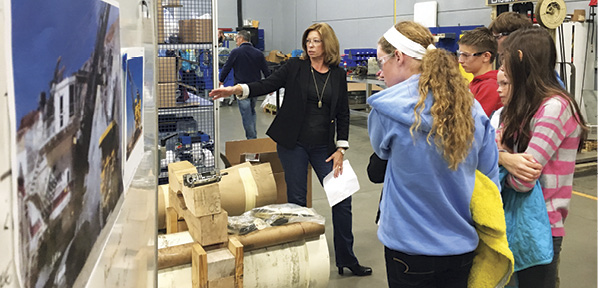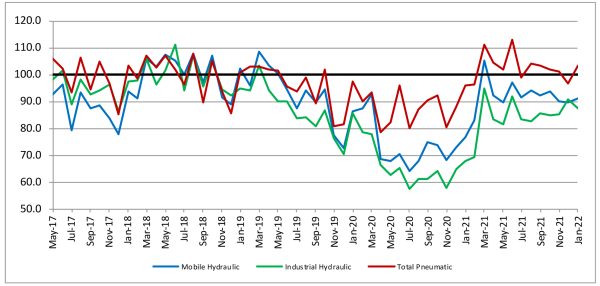What Will the Fluid Power Industry Look Like in 2023?
By Eric Lanke

At the NFPA Board of Directors meeting in February, Board and Strategic Task Force members participated in an exercise to create a view of the fluid power industry five years in the future. The purpose of the exercise was to identify a set of key factors likely to impact the fluid power industry in that time frame, and then create a set of action plans that the NFPA can implement ahead of the impact of those factors in order to best help its members thrive in a changing environment.
Five years ago, a Board-level task force completed a similar exercise and published a brief report on the then far-away future of the fluid power industry in 2018. That report speaks of a changing technological and geographic focus for the industry, and it was used by the Board in 2013 to better position NFPA as the association for the North American fluid power industry.
When the Board met in Orlando, everyone agreed it was time to look five more years into the future – to 2023 – and to make a set of similar decisions about the future focus and objectives of the association.
To help frame the first step in our discussion, we defined what we were looking for as a “megatrend,” an external force acting on our industry, something everyone agrees will create change in our environment, but for which few can accurately predict the full impact of that change. In that context, our Board and Strategic Task Force members discussed several critical issues – including globalization, electrification, and consolidation – but settled on just two megatrends that were perceived to have the greatest possible impact on our industry in the next five years: workforce and Internet of Things.
Creating an educated workforce for the fluid power industry is an issue NFPA and its Foundation have been addressing for some time. The fact that it remains a megatrend for our industry demonstrates how challenging the issue is. As a next step in the discussion, we worked to define what a positive future for the fluid power industry would look like relative to workforce, knowing that not all of the elements of that future may be in our association’s control. Here’s the picture we came up with:
In a future where fluid power has an easier time finding the skill sets it needs for growth and innovation:
- Engineering and technical programs have increased their focus on fluid power and have produced more fluid power-capable employees for the industry.
- Automation, including collaborative robots, has increasingly been used to fulfill tasks previously performed by people.
- Consolidation trends have had a synergistic impact on the industry’s employee base and have released more talent into the market.
- Fluid power companies have: (1) Increased wages to a degree that helps attract the right talent; (2) Changed their standards to allow more flexibility in culturally-driven behaviors (legal drug use, social media, etc.); and (3) Increased their use of internships and apprenticeships.
- People expected to retire have not.
- Electrification has increased to a point that it has replaced more fluid power applications, lowering the need for fluid power-specific talent.
- Fluid power companies have increased their sourcing from overseas to deal with the lack on U.S.-based expertise.
- Fluid power has leveraged the IoT trend to create exciting product and employment opportunities. As a result, the pool of candidates interested in our industry has increased.
- Changes in tax, immigration, and export policies have created less demand for U.S. jobs.
Internet of Things, on the other hand, is a megatrend that NFPA has almost no history in addressing. Here, too, we sought first to define what a positive future for the fluid power industry would look like:
In a future where fluid power benefits from integration with Internet of Things (IoT) technologies:
- The growth of fluid power products with IoT connectivity has kept up with or outpaced that of competing technologies.
- As a result of its integration with IoT technologies, fluid power has entered new applications and markets.
- OEMs have driven increased demand for fluid power products with embedded IoT technologies.
- Fluid power companies have increased their investment in the IoT skill sets of their workforce.
- Fluid power companies have increased their R&D budgets related to IoT technologies.
- There are international standards that support the use of IoT technologies in fluid power products.
- Major fluid power players have developed full IoT platforms and are offering subscription sales to those platforms.
- IoT technology providers are engaged as members of NFPA.
- IoT retrofit kits are available and in use by the fluid power industry.
- As a result of its integration with IoT technologies, non-IoT enabled equipment that is reliant on fluid power has been retired.
These descriptions, admittedly, are just the beginning of our process. When the Board comes back together in June 2018, we’ll begin talking about what NFPA can and should be doing to help make these two positive futures come true.








The increase in IoT equipment in industrial, mobile and even subsea and aerospace has indeed increased and usually the fluid power industry has been the leader coupled with data communications industry.
A lot of the changes to these markets has not been documented back to the NFPA and probably will never be reported but discovered at some time very close how much is already being done.
The legacy in this fluid power industry remains for one important reason. They know all the challenges that had to be met and endured them victoriously. That can be recorded of course, but the failures that were overcome and the mistakes that were repaired educate in a way the recorded information can never accomplish.